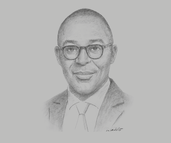Niamkey Isidore Tanoé, CEO, Atlantique Finance : Interview

Interview : Niamkey Isidore Tanoé
In what ways can Côte d’Ivoire’s capital markets be made more attractive?
NIAMKEY ISIDORE TANOÉ: Private equity financing can only be achieved through two channels: the Regional Securities Exchange (Bourse Régionale des Valeurs Mobilières, BRVM) and private investors. The third compartment of the BRVM is a step in the right direction, but it hasn’t gained as much popularity as hoped, as it attracts mainly larger small and medium-sized enterprises (SMEs). Looking at the available private investors in the country, we see overambitious firms looking for high return on investment (ROI) – as high as 15% to 20% – while still maintaining a low level of risk. Companies capable of meeting such strict criteria are very rare, and that’s one reason why private equity remains a scarce practice across the country.
Risk evaluation is one of the complex points on which opinions differ. Government officials and authorities believe that the risk in Côte d’Ivoire is lower than in Ghana or Kenya, as the West African region has assets like the CFA franc pegged to the euro and a central regional bank. However, perception of both local and international private business communities in the country is that risk is higher than officials believe. Therefore, private equity firms require a high ROI given the high level of perceived risk. Illustrating this, bond yields in Kenya average about 14%, whereas they average 6% in Côte d’Ivoire for a similarly perceived level of risk. Progression entails creating more flexible conditions for entrepreneurs, like reducing the three-year minimum period before issuing a bond or having a minimum of three balance sheets. The key is liberating the market rather than protecting it.
Another challenge that faces SMEs seeking private equity is the lack of preparation and financial skills among entrepreneurs. For SMEs to be stronger in accounting and financial performance, there must be greater development of the support offered by capital markets companies and banks. In order to develop private equity for SMEs, the market must be opened. It is vital to encourage entrepreneurs as well as foreign and local investors by implementing incentives that make the capital markets more attractive. Sufficient information and content must be produced that shows individual investors the potential of SMEs. The BRVM should be the main source of information, but media firms, journalists and private companies also share the responsibilities associated with this.
How do you assess the involvement of capital markets in funding the national economy?
TANOÉ: I believe that capital markets should be a lot more involved in the funding of the national economy. This includes, of course, major infrastructure projects. Although we have seen an increasing number of alternative models, the state must encourage these new types of funding as we move towards a financial system where banks cannot support the development of mega public projects on their own. The nature of infrastructure projects is, by definition, high in capital and low in risk. That’s why they are attractive for large foreign investing companies and foreign nations.
This also means that capital markets can be extremely helpful, with the condition that the sector has been adequately developed, has satisfactory ROI ratios for customers and high volumes of transactions are being processed. With regional capital markets that are performing well, nations can put in place hybrid models with bank loans, sovereign bonds and capital market participation. Lastly, we have seen projects worldwide being financed both partly and entirely via project bonds, and this model should be seen more frequently across Africa as a whole, and Côte d’Ivoire in particular. Project bonds allow infrastructure programmes to tap into available assets, and offer opportunities for institutional investors to participate in infrastructure projects through listed, tradeable securities that can offer higher returns.
You have reached the limit of premium articles you can view for free.
Choose from the options below to purchase print or digital editions of our Reports. You can also purchase a website subscription giving you unlimited access to all of our Reports online for 12 months.
If you have already purchased this Report or have a website subscription, please login to continue.

